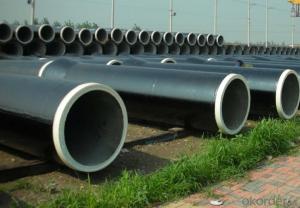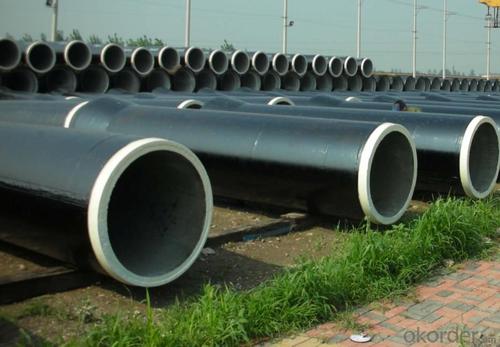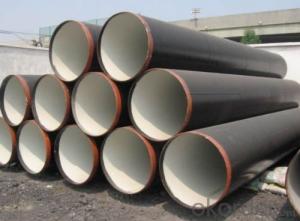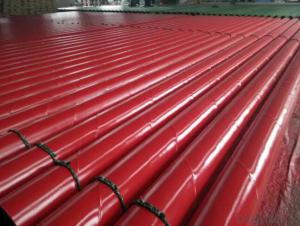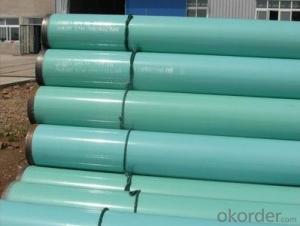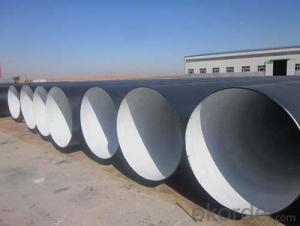HIGH QUALITY 3PE COATED STEEL PIPE
- Loading Port:
- China Main Port
- Payment Terms:
- TT OR LC
- Min Order Qty:
- -
- Supply Capability:
- -
OKorder Service Pledge
OKorder Financial Service
You Might Also Like
Packaging & Delivery
| Packaging Detail: | Plastic plugs in both ends Hexagonal bundles of max. 2000kg with several steel strips Two tags on each bundle Wrapped in waterproof paper PVC sleeve and sackcloth with several steel strips Plastic caps |
| Delivery Detail: | within 45 days after confirmation |
Specifications
API 5L PSL1/PSL2 Gr.B/X42/X52/X56/X60/X65/X70/X80 3PE/FBE Coated Line Pipe
OD: 2"-30",
WT:0.250"-4"
L:random,fixed,SRL,DRL
Application
Used for construction of long distance pipelines for combustible liquids and gases, nuclear station pipelines, heating system pipelines, general-purpose pipelines, vessels manufacturing, mechanical engineering and instrumental engineering.
DISTINCTIVES FEATURES
A) The External surface is shot-blasted (Sa 2 1/2) by removing millscale and rust, obtaining metal surface to facilities the adhesion.
B) The pipe is heated in a electric or gas oven at a controlled temperature.
C) The adhesive is then applied by hot meit or copolymer. It binds the polythylene to the steel.
D) Immediately afterwards, the extruded polyethylene/polyprophylene is coated on the pipe.
E) After application of the polyethylene/polyprophylene, the pipe is coated by spraying water.
Process
SEAMLESS
HOT ROLLED
COLD DRAWN
WELDED
ERW (Electric Resistance Welded)
HFI (High Frequency Induction)
EFW(ELECTRIC FUSION WELDED TUBE)
LSAW (Longitudinal Submerge-arc Welded) UO(UOE),RB(RBE),JCO(JCOE)
DSAW (Double Submerged arc welded)
SAW (Spiral Welded)
SSAW (Spiral Submerged-arc Welded)
Quality Standard
SEAMLESS PROCESS
GB/T 8163 Seamless steel tubes for liquid service
ASTM A106 Standard Specification for Seamless Carbon Steel Pipe for High-Temperature Service
DIN 1629 SEAMLESS CIRCULAR TUBES OF NON ALLOY STEELS WITH SPECIAL QUALITY REQUIREMENTS
API 5L Line Pipe
WELDED PROCESS
ERW HFI , EFW, LSAW, DSAW
GB/T3091 Welded steel pipe for low pressure liquid delivery
GB/T9711 Petroleum and natural gas industries--Steel pipe for pipelines
EN10217 Welded steel tubes for pressure purposes.
IS 3589 Steel tubes for water and sewage
IS 1978-1982 Steel tubes for use in transportation of oil; gas & Petroleum products
BS 1387 Steel Tubes for use for Water, Gas, Air and Steam
ASTM A53 Standard Specification for Pipe, Steel, Black and Hot-Dipped, Zinc-Coated, Welded and Seamless
DIN 2458 WELDED STEEL PIPES AND TUBES
API 5L Line Pipe
SAW SSAW
SY/T5037 Spiral submerged arc-welded steel pipe for pipelines for low pressure field fluid service
SY/T 5040 Spiral submerged arc-welded steel pipe piles
CJ/T 3022 Spiral submerged-arc welded steel pipe for municipal heat supply
IS 1978 Steel tubes for use in transportation of oil; gas & Petroleum products
API 5L Line Pipe
Coating Standard
ANSI/AWWA C104/A21.4 American National Standard for Cement-Mortar Lining for Ductile-Iron Pipe and Fittings for Water
ISO 21809 Petroleum and natural gas industries -- External coatings for buried or submerged pipelines used in pipeline transportation systems
DIN 30670 Polyethylen coatings of steel pipes and fittings
Steel Grade
SEAMLESS PROCESS
GB/T 8163 10# 20# 35# 45# 16MN(Q345B)
GB 3087 10# 20# 35# 45# 16MN(Q345B)
GB 5310 20G 12Cr1MoV 12Cr1MoVG 12CrMoG
ASTM A106 Gr A Gr B Gr C
DIN 1629 St 37.0 St 44.0 St 52.0
API 5L A B X42X46 X52 X60 X65 X70 X80
WELDED PROCESS
GB/T3091 SY/T5037 SY/T 5040CJ/T 3022
Q195 Q215 Q235 Q275 Q295 Q345 08F 08 08AL 08F 10F 10 HG5 DF08 SPHC M8
BS 1387 EN10217 S185 S235 S235JR S235 G2H S275 S275JR S355JRH S355J2H St12 St13 St14 St33 St37 St44 ST52
ASTM A 53 Gr. A Gr B Gr C Gr.D
API 5L A B X42 X46 X52 X56 X60 X65 X70
GB/T9711 L175 L210 L245 L290 L320 L360 L290 L320 L360 L390 L415 L450 L485 L555
Size
SEAMLESS PROCESS
Outer Diameter Hot finish 2" - 30" Cold drawn 0.875" - 18"
Wall Thickness Hot finish 0.250" - 4.00" Cold drawn 0.035" - 0.875"
Length Random Length Fixed Length SRL DRL
WELDED PROCESS
ERW HFI EFW
Outer Diameter 6mm-610mm (1/16"-24")
Wall Thickness 0.3mm-22mm
Length 0.5mtr-20mtr
LSAW DSAW
Outer Diameter 219mm-1820mm
Wall Thickness 5.0mm-50mm
Length 6mtr-18mtr
SAW SSAW
Outer Diamter 219.1mm - 4064mm (8" - 160")
Wall Thickness 3.2 mm - 40mm
Length 6mtr-18mtr
End
square ends (straight cut saw cut and torch cut);
beveled for welding (All line piping is square cut to the tolerance specified and bevelled to ANSI B16.25. An angle of 30º (-0º +5º) and a landing of 16 mm ±08 mm is applied. Schedule 160 material is supplied without bevelling.)
Surface Lightly oiled Hot dip galvanized Electro galvanized Black Bare Varnish coating/Anti rust oil Protective Coatings (Coal Tar Epoxy Fusion Bond Epoxy 3-layers PE)
Test Chemical Component Analysis Mechanical Properties (Ultimate tensile strength Yield
strength Elongation) Technical Properties (Flattening Test Bending Test Hardness Test Blow Test Impact Test etc.) Exterior Size Inspection Hydrostatic Test(The standard pressure is limited to 207 MPa (3000 psi)) X-ray Test.
Mill Test Certificate EN 10204/3.1B
Third party inspection SGS BV Lloyds etc.
- Q: Can steel pipes be used for wastewater disposal?
- Yes, steel pipes can be used for wastewater disposal. Steel is a durable and corrosion-resistant material, making it suitable for transporting and disposing of wastewater safely and efficiently.
- Q: What is the difference between internal and external coating of steel pipes?
- The main difference between internal and external coating of steel pipes is their purpose and the materials used. The internal coating is applied to the inside surface of the pipe to protect it from corrosion, erosion, and chemical reactions with the transported fluids. It is typically made of materials such as epoxy or polyethylene. On the other hand, the external coating is applied to the outside surface of the pipe to provide protection against atmospheric corrosion, soil corrosion, and mechanical damage. External coatings are usually made of materials like fusion-bonded epoxy, polyethylene, or polypropylene.
- Q: How do you calculate the pipe friction loss for steel pipes?
- To calculate the pipe friction loss for steel pipes, you need to use the Darcy-Weisbach equation. This equation is commonly used in fluid dynamics to determine the pressure drop or friction loss due to the flow of fluid through a pipe. The equation is as follows: ΔP = (f * L * ρ * V²) / (2 * D) Where: ΔP = Pressure drop or friction loss f = Darcy friction factor L = Length of the pipe ρ = Density of the fluid V = Velocity of the fluid D = Diameter of the pipe The Darcy friction factor (f) is a dimensionless value that depends on the Reynolds number (Re) and the relative roughness (ε/D) of the pipe, where ε is the absolute roughness of the pipe. To determine the friction factor, you can use various correlations or Moody's diagram. Once you have the friction factor, you can plug in the values for length, density, velocity, and diameter into the equation to calculate the pressure drop or friction loss. It is important to note that the units of all the variables should be consistent (e.g., length in meters, density in kg/m³, velocity in m/s, diameter in meters) to obtain accurate results. By using this equation and obtaining the necessary parameters, you can calculate the pipe friction loss for steel pipes, which is crucial in designing and analyzing fluid flow systems.
- Q: Are steel pipes suitable for use in chemical plants?
- Yes, steel pipes are suitable for use in chemical plants. Steel pipes offer excellent resistance to corrosion, high durability, and can withstand high temperatures and pressures commonly found in chemical processing. Additionally, steel pipes can be easily welded, making them versatile for various chemical applications.
- Q: Are steel pipes suitable for underground sewage lines?
- Yes, steel pipes are suitable for underground sewage lines. They are strong, durable, and resistant to corrosion, making them an excellent choice for sewage systems.
- Q: How are steel pipes classified according to their use?
- Steel pipes can be classified according to their use into various categories such as structural pipes, plumbing pipes, oil and gas pipes, water supply pipes, and industrial pipes.
- Q: How are steel pipes insulated to prevent condensation?
- Steel pipes are typically insulated using materials such as foam or fiberglass wraps, which act as a barrier between the cold pipe surface and the surrounding air. This insulation prevents the formation of condensation by reducing heat transfer and maintaining the pipe temperature above the dew point of the air.
- Q: Can steel pipes be used for geothermal systems?
- Yes, steel pipes can be used for geothermal systems. Steel pipes are commonly used in geothermal systems for their high strength, durability, and ability to withstand high temperatures and pressures. They are also resistant to corrosion, making them suitable for long-term use in geothermal applications.
- Q: How do you prevent steel pipes from freezing in cold climates?
- To prevent steel pipes from freezing in cold climates, it is important to insulate the pipes properly. This can be done by wrapping them with insulation sleeves or foam, which helps to retain heat and prevent rapid temperature changes. Additionally, ensuring that there is proper ventilation in the area where the pipes are located can help to maintain a higher temperature and prevent freezing.
- Q: How are steel pipes protected against electromagnetic interference?
- Steel pipes can be protected against electromagnetic interference by applying a layer of insulating material around the pipes or by utilizing electromagnetic shielding techniques such as wrapping the pipes with conductive materials. Additionally, grounding the pipes and implementing proper grounding practices can help minimize the impact of electromagnetic interference.
Send your message to us
HIGH QUALITY 3PE COATED STEEL PIPE
- Loading Port:
- China Main Port
- Payment Terms:
- TT OR LC
- Min Order Qty:
- -
- Supply Capability:
- -
OKorder Service Pledge
OKorder Financial Service
Similar products
Hot products
Hot Searches
Related keywords
